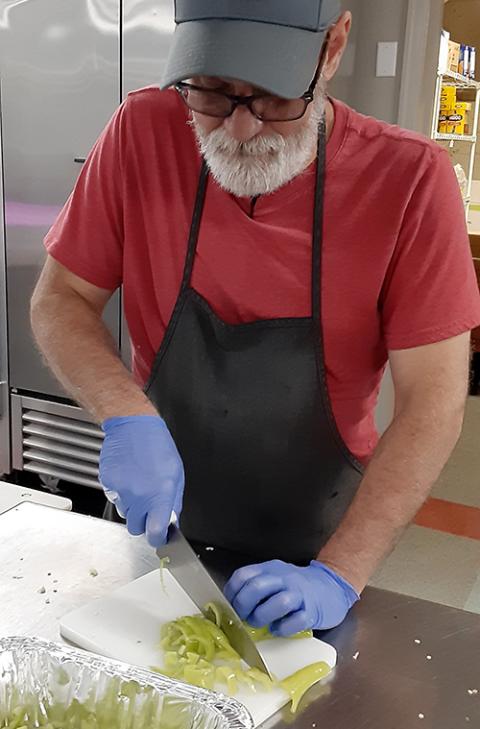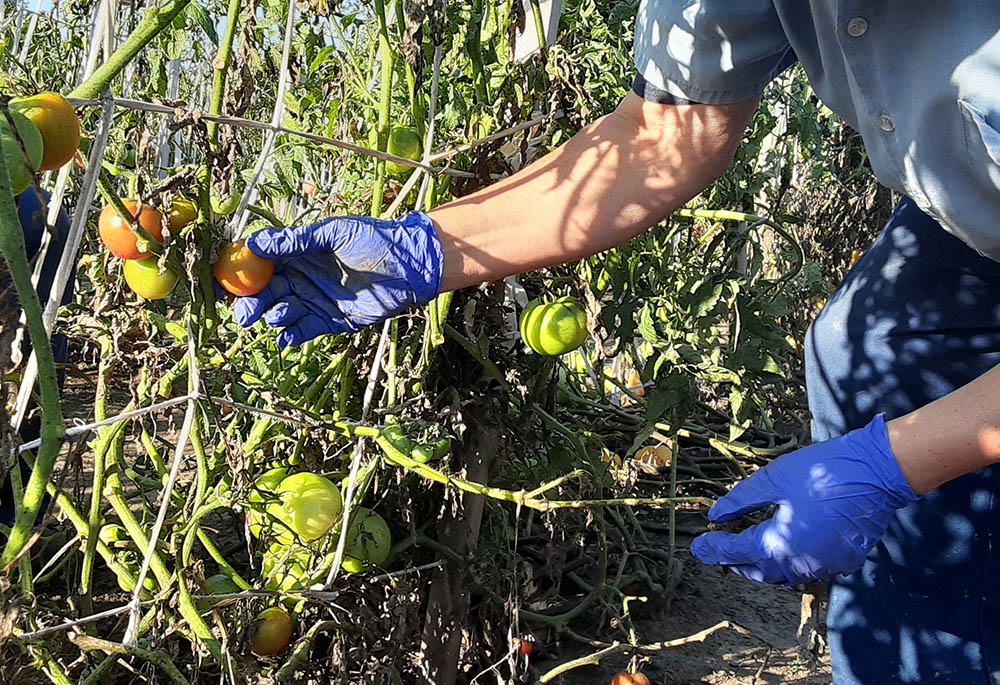
Mike, an incarcerated man, checks tomatoes for damage following a severe thunderstorm at the inmate-run farm at the Grafton Correctional Institution in rural Lorain County, Ohio. (Dennis Sadowski)
His blue prison work pants and gray shirt spotted with mud, Mike scans a row of tomato vines to see if he has missed tying off any that might still be on the ground after a recent thunderstorm pelted the plants with heavy rain, wind and hail.
Satisfied that all the vines have been tied, he walks to a nearby row to give a hand to his friend Dave, who's cradling in his right hand a cluster of plump green fruit on the verge of ripening. Dave finds a spot to tie the vine to a trellis with a strip of cloth.
"We can use some string," he calls out. Thor, another garden worker a couple of rows away, tosses a ball of cloth strips to Dave, who makes a deft left-handed catch, careful not to drop the tomatoes in his other hand. He ties off the vine and moves on.
The men continue their work as the sun rises on an unseasonably cool late August day over this one-acre garden plot on the grounds of the Grafton Correctional Institution, in rural Lorain County 30 miles southwest of Cleveland.
Mike, who like the other inmates asked that only his first name be used for this story, explained that it's important to take care of not just the tomatoes, but the zucchini, cabbage, peppers, lettuce, onions and squash he and a team of 23 incarcerated men are growing. They appreciate that the produce in their care is feeding hungry people at the Diocese of Cleveland Catholic Charities' pantry and meal programs.
"It's a way to give something back," Mike said.
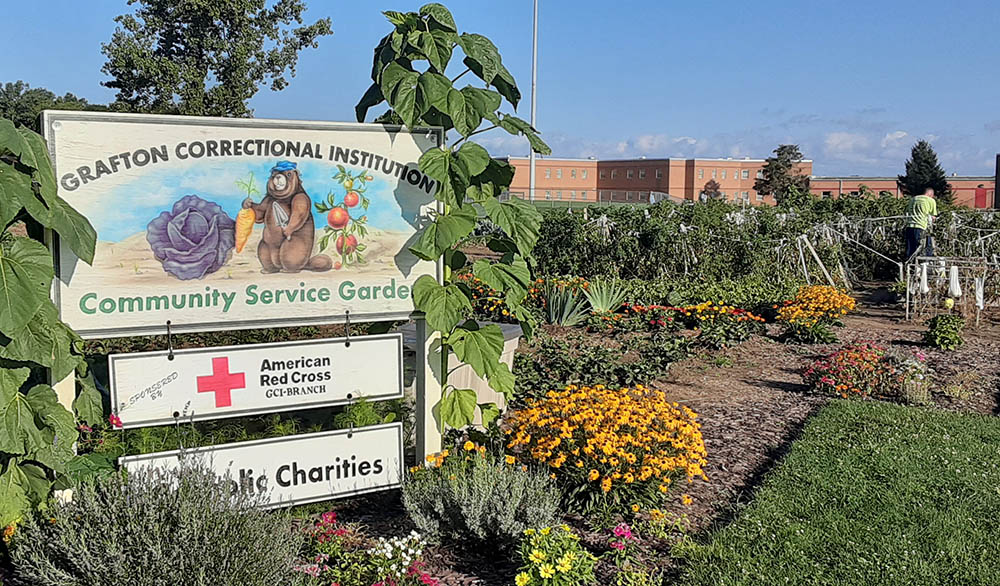
A sign announces the collaborative effort among the inmates and staff at the Grafton Correctional Institution with the American Red Cross and Catholic Charities of the Cleveland Diocese. The men grow a variety of vegetables, including tomatoes, cucumbers, peppers, squash, zucchini, eggplant and onions, for Catholic Charities' food pantry and meal programs. (Dennis Sadowski)
It's Mike's third growing season, working in what started as a small garden in 2020 in the middle of the coronavirus pandemic and expanding each year since. He enjoys the peace and tranquility the garden provides.
This year alone, Catholic Charities food programs at the Bishop Cosgrove Center in downtown Cleveland and St. Elizabeth Center in nearby Lorain have received 12,500 pounds of fresh vegetables. With the growing season set to last at least through mid-October, this year's 15,000-pound goal is within reach.
"We're told the people are appreciative of getting the vegetables," said Mike, who called himself a cradle Catholic. "People are getting fed. It also saves the diocese money."
The gardeners described other benefits as well: being outside, whether under the sun or in a soothing rain; gaining peace of mind; feeling relaxed and less stressed; and envisioning a future full of hope rather than anger and despair.
"The biggest thing is knowing we've fed so many people and to be part of something bigger than myself," Antoine, another gardener, said.
Catholic Charities connection
The garden started modestly, with seven volunteers and a small plot that produced 1,300 pounds of vegetables.
Notre Dame Sr. Rita Mary Harwood, who was the diocese's secretary of parish life and development before retiring in August 2021, suggested to prison officials that a garden would help feed people at a time when supply chains were disrupted and people went out only when necessary.
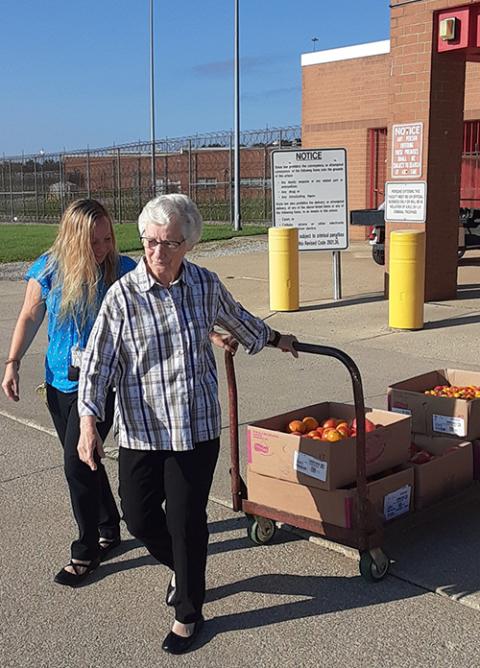
Notre Dame Sr. Rita Mary Harwood, assisted by Brooke Schramm, a correctional program specialist, wheels boxes of vegetables grown by inmates at the Grafton Correctional Institution. (Dennis Sadowski)
Harwood, who joined the diocese in 1995, had overseen the development of a diocesanwide jail and prison ministry, which today has about 450 parish volunteers. Through her connection with Grafton's administrators, she was aware that the institution also had a tacking shop where men sewed a variety of products for the community.
When the pandemic hit, Jennifer Gillece Black, warden at the time, asked if the diocese needed anything specific from the tackers.
Unsure, Harwood approached Patrick Gareau, president and CEO of Catholic Charities. He told her the agency was running low on face masks. Harwood asked Gillece Black about making masks and the men quickly shifted into high gear.
At times, they worked 12-14 hours a day at the height of the pandemic, sewing about 49,000 masks by the time it ran its course. They were distributed to Catholic Charities staff and its program sites and then to diocesan schools, nursing homes and elsewhere, Harwood said.
She credited the correctional institution's administrators for "not only being cooperative, but they encourage the men to think of solutions and to think of ways that things can be done."
With a long history of collaboration, asking for a garden was easy for Harwood. From there, the incarcerated men ran with the idea, Deputy Warden Stephen Reynolds told NCR.
The vegetable garden has expanded each summer, growing in size and the number of men who volunteer. In 2021, there were 11 volunteers who raised 3,000 pounds of vegetables. The next year 16 men grew 9,000 pounds.
Catholic Charities and the Catholic Action Commission of Lorain County have honored the "Men of Grafton" for their efforts, saying they have helped hundreds of people in need.
Without providing an exact dollar value, Gareau told NCR the produce grown in Grafton "helps the budget" of Catholic Charities. The money saved by not having to buy as many vegetables can be used for other valuable programs, he said.
"These men will come out way better off than when they went in in a big measure because of the way they've been able to connect to the community," he said.
Gareau credited Boyert's Greenhouse and Farm in Medina, about 30 minutes from the institution, for donating vegetable and flower plants for the garden the last two growing seasons.
The people who visit the pantry and meal programs also appreciate receiving a bag of fresh vegetables or eating a nutritious meal.
Ashford Perkins, 36, who is without a home and was waiting in late August for an opening at St. Elizabeth Center's 50-bed men's shelter, said he has enjoyed food he has never eaten before.
"I like the food they make. It's good. It's always different," Perkins said.
Cooks Andy Meloche and Carlos Toro look for imaginative and tasty ways to prepare the different peppers, squash and zucchini they receive.
"I'm not going to buy Hungarian peppers, but when I have them, I'm going to make 10 different dishes. It's a way to be creative with the food that we get," Meloche said.
Changing outlooks
Richard is the liaison between the men growing vegetables and the correctional institution's administrators. He said the effort is helping the men focus on something more than themselves.
"It's the idea that we're trying to change the culture in here," said Richard, who is taking classes through a seminary and plans to establish a food ministry when his sentence ends next year.
"The garden has become a way for the guys to understand that it's a bit bigger than just us. There's a lot of people in need. One of the best ways to deal with your own pain and issues in life is to focus on the needs of other people," he said.
Advertisement
Whether it's the gardeners, the tackers or the men in other skill-development programs, Reynolds said the goal is to help the men "engage in doing something positive to give back."
"Once they get involved in stuff like that, it gives them something to wake up for every morning," he said.
In the past, prisons often operated under the philosophy of "lock and feed," meaning holding people until their sentences ended and doing little to engage them. Reynolds, 55, who has worked in corrections for 30 years, admitted thinking along those lines in the past.
Over time, he and others have realized the importance of involving incarcerated men in positive endeavors. The result, Reynolds said, has been a positive environment throughout the sprawling Grafton Correctional Institution, which houses 1,200 men.
"In any of the programs, I see the men engaging in meaningful activities," he continued. "I see the hope that's instilled in them and the benefits that they gain from knowing they're doing something in giving back to the society is paying off in the institution. Our violence is down. Our assaults are down. The atmosphere in the institution is one more of collaboration than what you see in most prisons."
Tackers shift to meet needs
With the pandemic's decline, the tackers shifted from producing masks to sewing other products. The work area has about 10 sewing machines. Letters of thanks from children adorn the walls. One child thanked the men for "the best mask I ever had."
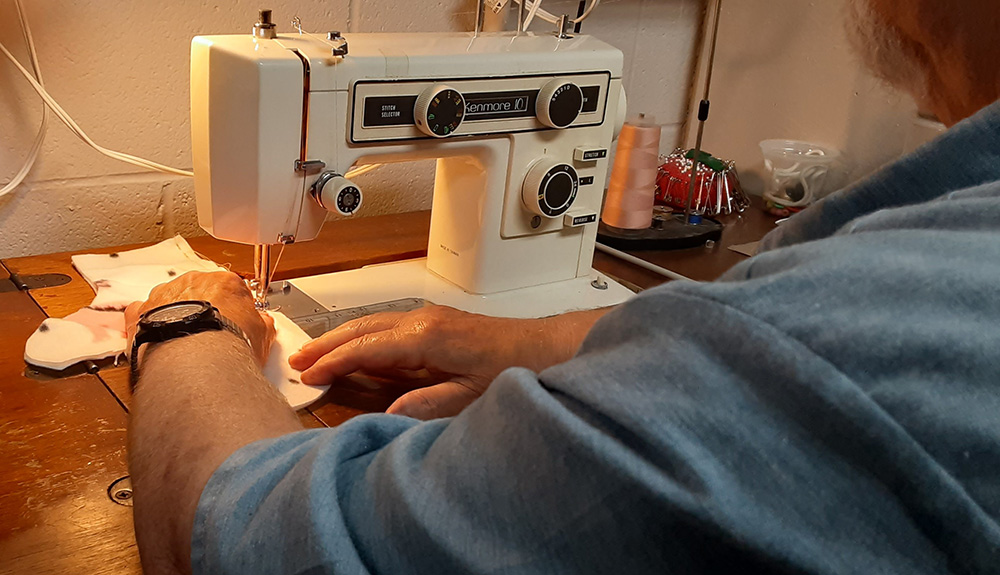
Joe, an inmate at the Grafton Correctional Institution, sews a mitten Aug. 28 that will be distributed through Catholic Charities of the Cleveland Diocese this winter. (Dennis Sadowski)
On a recent morning, Martin, a tacker, was at a sewing machine making a duffel bag designed for an unhoused person. Its design includes pockets of different shapes and sizes so the user can more easily arrange belongings.
"We feel we are saving lives," Martin said of the items the men sew. Some products have been shipped as far as southern Texas for newly arrived immigrants.
The 11 men who volunteer as tackers up to 20 hours a week this year have made mittens, winter hats, sun hats, scarves, blankets, window curtains, tote bags, placemats and wheelchair bags — more than 1,200 items and counting with an estimated value of about $15,700.
Harwood said the work of the men, whether growing food or sewing practical items, "is truly a partnership" with the diocese. "They look forward to doing this," she said.
"They pride themselves in the fact that we together have created a partnership that is benefiting everybody," she added. "It's benefiting those who are inside and benefiting everybody outside. It's a beautiful example of what it means to care for one another."

